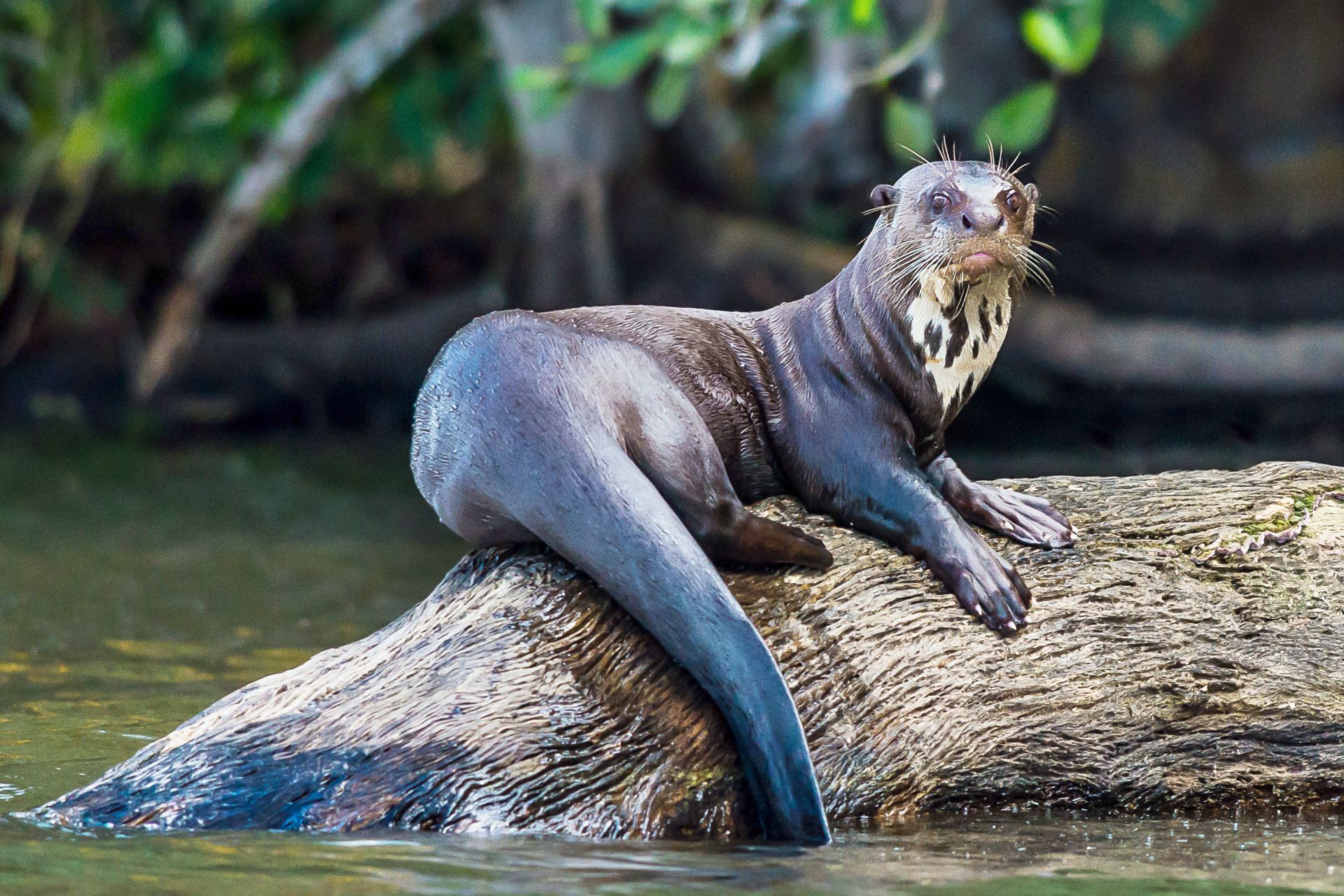https://www.activewild.com/list-of-endangered-animals/?utm_source=brevo&utm_campaign=AW%20Newsletter%2028&utm_medium=email
Blue Speckled Tree Monitor
Scientific name: Varanus macraei
Type of animal: Reptile
Where found: Asia
The blue-speckled tree monitor is a monitor lizard found only on Batanta island, part of the island country of Indonesia. The species, which is also known as the blue-spotted tree monitor, grows to around 3.5 ft (1.1 m) in length, & it is black with blue scale patterns.
Equipped with a long, prehensile tail that helps it climb, the blue-speckled tree monitor is largely arboreal (tree-living). It is found in tropical forests.
Why are blue-speckled tree monitors endangered?
The blue-speckled tree monitor is targeted by hunters who collect live specimens for sale to the pet trade. Deforestation is another threat to the species.
Blue Whale
Scientific name: Balaenoptera musculus
Type of animal: Mammal
Where found: Oceans worldwide
Blue whales are the largest animals ever to have lived on the Earth; they’re bigger than the biggest dinosaurs. Blue whales can weigh up to 200 tons, yet their diet consists almost entirely of tiny crustaceans called krill.
Why are blue whales endangered?
Blue whales are endangered due to historic overhunting. The species was once hunted almost to extinction. Today, the blue whale is protected worldwide & is making a slow recovery. However, with a population that currently numbers between 5,000 & 15,000 adult individuals, the blue whale remains an endangered species.
Bonobo
Scientific name: Pan paniscus
Type of animal: Mammal
Where found: Africa
Bonobos are very similar to chimpanzees (both species belong to the genus Pan), but are usually slightly smaller, with longer legs & darker faces. Bonobos are found in the tropical forests of the Democratic Republic of Congo, Africa.
Why are bonobos endangered?
The bonobo is endangered due to poaching (hunting of the bonobo for bushmeat continues despite being banned) & habitat loss caused by logging & slash & burn agriculture.
Chimpanzee
Scientific name: Pan troglodytes
Type of animal: Mammal
Where found: Africa
Chimpanzees are primates that live in the forests of central Africa. They are our nearest living relatives, sharing around 98% of our genes. They belong to the great ape family Hominidae, along with humans, bonobos, gorillas, & orangutans.
These intelligent apes are among the very few animals known to use tools. Chimpanzees have been observed using sticks to extract insects such as termites & bees from their nests, & stones to crack open nuts.
Why are chimpanzees endangered?
The greatest threat to the chimpanzee is poaching; despite being protected, the species is targeted by hunters for its meat.
Dhole
Scientific name: Cuon alpinus
Type of animal: Mammal
Where found: Asia
Also known as the Asian wild dog, the dhole is a canid (member of the dog family, Canidae) found in several Asian countries, including India, Bangladesh, & China, & also the islands of Sumatra & Java.
Despite its large range, the dhole’s population is thin & fragmented. The entire adult wild population of dholes is thought to number a maximum of 2,215 individuals.
Why are dholes endangered?
One of the main reasons that the dhole is endangered is competition with human hunters. Overhunting of the dhole’s natural prey by humans creates a scarcity of food for the dogs. Habitat loss has also played a large part in the species’ endangered status.
Egyptian Vulture
Scientific name: Neophron percnopterus
Type of animal: Bird
Where found: Africa, Asia, Europe
The Egyptian vulture is found across a large part of southern Europe, northern Africa, & Asia. It is a striking bird with white plumage, a yellow face & a 5.58 ft. / 1.7 meter maximum wingspan.
Like most vultures, the Egyptian vulture is primarily a scavenger.
Why are Egyptian vultures endangered?
Today, much of the carrion eaten by the Egyptian vulture contains either poison or lead shot, which eventually proves fatal for the scavenger. In addition, drugs administered to livestock upon whose carcasses the vulture preys are harmful to the bird. Collisions with wind turbines & electrical cables also reduce the bird’s population.
European Rabbit
Scientific name: Oryctolagus cuniculus
Type of animal: Mammal
Where found: Native to Europe, introduced to the Americas, Africa & Australia
The European rabbit is a common sight in some parts of the world, but in its native Spain, Portugal, & southern France, the species' population has declined significantly in recent years, causing the species to become endangered.
The rabbit, one of 77 species of rabbits & hares, was introduced to regions as far afield as the Americas & Australia. Due to the damage the species can cause to crops, it came to be considered a pest in many areas in which it had been introduced.
One method of controlling introduced populations of European rabbits was the deliberate introduction of the disease Myxomatosis. This disease, together with another, Rabbit Haemorrhagic Disease, has been responsible for wiping out large numbers of European rabbits not only in regions to which the species was introduced, but also in its native range.
The decline of the European rabbit has led to the decline of one of its main predators: the Iberian lynx.
Why Is The European Rabbit Endangered?
The European rabbit is endangered primarily due to the introduction of the disease Myxomatosis.
Galápagos Penguin
Scientific name: Spheniscus mendiculus
Type of animal: Bird
Where found: Galápagos Islands
The Galápagos penguin is found on the Galápagos Islands, an island group in the Pacific Ocean 563 miles off the coast of Ecuador. The Galápagos penguin is the only penguin found north of the equator. It is the second-smallest penguin: only the little penguin is smaller.
Why are Galápagos penguins endangered?
The Galápagos penguin’s population is strongly affected by ENSO (the El Niño-Southern Oscillation), a cycle of warm & cold sea temperatures in the Eastern Pacific Ocean. In El Niño years, the water temperature rises, causing food to become scarce for the penguins.
Galápagos Sea Lion
Scientific name: Zalophus wollebaeki
Type of animal: Mammal
Where found: Galápagos Islands
The Galápagos sea lion lives on the coast of the Galápagos islands. It is the smallest sea lion species. There are only around 10,000 Galápagos sea lions left in the wild.
Why are Galápagos sea lions endangered?
Like the Galápagos penguin, the Galápagos sea lion is affected by El Niño events. These cause a reduction in the amount of available food & a resultant poor breeding season. Disease (possibly spread by dogs) also causes significant declines in the sea lion’s population.
Giant Abalone
Scientific name: Haliotis gigantea
Type of animal: Mollusk
Where found: Oceans surrounding Japan
The giant abalone is a sea snail found in the seas off of Japan & South Korea. It grows to a diameter of around 23.3 cm / 9.17 in. &, like all abalones, has a row of respiratory holes on its shell.
Abalones, like all sea snails, are mollusks belonging to the class Gastropoda. This group is home to all snails (including land-living varieties) & slugs.
Many abalones, including the giant abalone, are harvested for food, & overfishing is a principal cause of the species’ endangered status. The loss of the seaweed beds upon which the giant abalone is found is another contributing factor.
Giant Otter
Scientific name: Pteronura brasiliensis
Type of animal: Mammal
Where found: South America
The giant otter is a species of otter found in South America. It is present in the Amazon River & the Pantanal (a vast tropical wetland). Like other otters, it is a semi-aquatic hunter. Its diet consists almost entirely of fish.
As its name suggests, the giant otter is one of the larger otter species, reaching 1.8 m / 5 ft 11 in. in length. Like other otters, it is a member of the weasel family, Mustelidae.
Previously the victim of overhunting for its pelt, the giant otter today is threatened by human encroachment into its habitat, as well as by pollution & disease.
Golden Lion Tamarin
Scientific name: Leontopithecus rosalia
Type of animal: Mammal
Where found: South America
The golden lion tamarin is a monkey that lives in Brazil’s Atlantic Coastal Forest.
The species belongs to a group of primates called the New World monkeys. This group split from the Old World monkeys around 40 million years ago. The nostrils of New World monkeys open to the sides, whereas those of Old World monkeys open downwards.
Why are golden lion tamarins endangered?
The primary cause of the golden lion tamarin’s endangered status is deforestation. Over 85% of the Atlantic Coastal Forest in which the monkey lives has been destroyed. In addition, the golden lion tamarin is hunted for sale to the pet trade.
Golden Poison Frog
Scientific name: Phyllobates terribilis
Type of animal: Amphibian
Where found: South America
The golden poison frog is a brightly-colored frog that lives in the rainforests of Colombia. It is the largest species of poison dart frog, reaching a length of 55 mm / 2.17 in. As well as its characteristic yellow, the species’ skin can also be green or orange in color.
The golden poison frog’s bright coloration warns potential predators that it is poisonous. The species is considered by many to be the world’s most poisonous vertebrate.
Why are golden poison frogs endangered?
Like many rainforest animals, the primary threat to the golden poison frog is deforestation.
Cute Critters:
Weekly Chuckle:










No comments:
Post a Comment